|
 
 |
|
CASE REPORT |
|
|
|
| Year : 2014 | Volume
: 20
| Issue : 2 | Page : 195-198 |
| |
Omphalocele, exstrophy of cloaca, imperforate anus and spinal defect (OEIS Complex) with overlapping features of body stalk anomaly (limb body wall complex)
Suresh R. S. Mandrekar1, Sangeeta Amoncar1, Siddhartha Banaulikar2, Vishal Sawant3, R. G. W. Pinto1
1 Department of Pathology, Goa Medical College, Bambolim, Goa, India
2 Department of Forensic Medicine, Goa Medical College, Bambolim, Goa, India
3 Department of Paediatric Surgery, Goa Medical College, Bambolim, Goa, India
| Date of Web Publication | 14-Oct-2014 |
Correspondence Address:
Suresh R. S. Mandrekar
2 Antil Peth, Bicholim - 403 504, Goa
India
 Source of Support: None, Conflict of Interest: None
DOI: 10.4103/0971-6866.142906

 Abstract Abstract | | |
OEIS is an extremely rare constellation of malformations, which includes omphalocele, exstrophy of cloaca, imperforate anus, and spinal defect. We report here autopsy findings in a case of OEIS complex, which apart from the major anomalies of the complex had bilateral club foot that is, congenital talipes equinovarus, right hydroureter, and body stalk anomaly. The umbilical cord was absent, and the umbilical vessels were embedded in an amniotic sheet, which connected the skin margin of the anterior body wall defect to the placenta, this feature being the hallmark of limb body wall complex (LBWC). This case further supports the view that OEIS and LBWC represent a continuous spectrum of abnormalities rather than separate conditions and may share a common etiology and pathogenetic mechanism as proposed by some authors.
Keywords: Body stalk anomaly, limb body wall complex, OEIS complex (omphalocele, exstrophy of cloaca, imperforate anus and spinal defect)
How to cite this article:
Mandrekar SR, Amoncar S, Banaulikar S, Sawant V, Pinto R. Omphalocele, exstrophy of cloaca, imperforate anus and spinal defect (OEIS Complex) with overlapping features of body stalk anomaly (limb body wall complex). Indian J Hum Genet 2014;20:195-8 |
How to cite this URL:
Mandrekar SR, Amoncar S, Banaulikar S, Sawant V, Pinto R. Omphalocele, exstrophy of cloaca, imperforate anus and spinal defect (OEIS Complex) with overlapping features of body stalk anomaly (limb body wall complex). Indian J Hum Genet [serial online] 2014 [cited 2016 Aug 23];20:195-8. Available from: http://www.ijhg.com/text.asp?2014/20/2/195/142906 |
 Introduction Introduction | |  |
The major syndrome complex anomalies associated with anterior abdominal wall defect includes omphalocele, exstrophy of cloaca, imperforate anus and spinal defect (OEIS) syndrome, limb body wall complex (LBWC) and Pentalogy of Cantrell.
OEIS complex which includes a constellation of malformations represents the most severe form of exstrophy-epispadias complex. [1] OEIS and exstrophy of cloaca are used synonymously and has an estimated frequency of 1:200,000-400,000 live births. Most cases are sporadic with no obvious etiology. The few reported patients with family members having similar malformations or with chromosomal anomalies suggest a genetic contribution. Other reports have linked it to certain exposures, twinning, and in vitro fertilization. [2]
Limb body wall complex also called as body stalk complex and cyllosomas, refers to congenital defect, which includes at least two of the following characteristics. (1) Exencephaly/encephalocele with facial clefts (2) thoraco-abdominoschisis/ventral body wall defect and (3) limb defects. [3] Russo et al. have proposed two clearly distinguishable phenotypes: The "placento-cranial" and "placento-abdominal" for this complex. [4] Fetuses with "placento-cranial defects" are characterized by (a) encephalocele or exencephaly always associated with facial clefts and (b) amniotic band between the cranial defects and placenta. Fetuses with "placento-abdominal defects" present with urogenital anomalies, anal atresia, lumbosacral meningocele, and placental anomalies such as presence of short cord, persistence of extra-embryonic coelom, and intact amnion. [4]
Pentalogy of Cantrell or thoraco-abdominal syndrome is characterized by anterior abdominal wall defect (omphalocele), anterior diaphragmatic hernia, sternal cleft, ectopia cordis, and intracardiac defects. [5]
OEIS complex may be difficult to diagnose prenatally, and the full extent of the abnormalities may not be clear until postnatal examination. Confusion with LBWC and Pentalogy of Cantrell can occur. Additional finding of thoracic defect and absent spine defect may distinguish Pentalogy of Cantrell from OEIS complex on prenatal ultrasonography. [6]
The overlap of features found among LBWC and OEIS (cloacal exstrophy) cases represent a continuous spectrum of abnormalities, rather than separate conditions and may also share a common etiology or pathogenetic mechanism. [7]
 Case Report Case Report | |  |
A preterm baby (26-28 weeks) that was delivered by spontaneous vaginal delivery by a unbooked primigravida mother expired within 1 h of birth and was referred for a detail postmortem examination, as the baby had a large omphalocele. No antenatal history or ultrasound findings were available.
On external examination, the head circumference was 28 cm, the crown rump length was 24 cm, crown heel length was 36 cm, and the fetus weighed 1.4 kg. The external genitalia were undeveloped. There was kyphoscoliosis of the thoracolumbar spine [Figure 1] with a lumbosacral meningocele measuring 3 cm, which on cut section contained serous fluid with no neural tissue or cord tissue. There was a large defect of the lower anterior abdominal wall (omphalocele) the contents of which included liver, spleen, and loops of small intestine [Figure 2]. The umbilical cord was absent, and the umbilical vessels were embedded in an amniotic sheet, which connected the skin margin of the anterior body wall defect to the placenta [Figure 3] and [Figure 4]. There was exstrophy of the cloaca with opening of the ileum [Figure 4] which showed meconium coming out [Figure 1], opening of the colon with a blind loop measuring 5 cm [Figure 5] and two lateral hemibladders with ureteral openings. The thorax was narrow, there was bilateral club foot and anus was imperforate [Figure 1] and [Figure 2]. On opening the thoracic cage and abdomen, the right lung showed three lobes, the left showed two lobes. The heart and the great vessels were normal. There was no tracheoesophageal anomaly/duodenal atresia. Right kidney showed massive hydroureter [Figure 6], but no hydronephrosis. The left kidney and ureter was normal. Right gonad was identified, which was histologically testis. Left gonad could not be identified.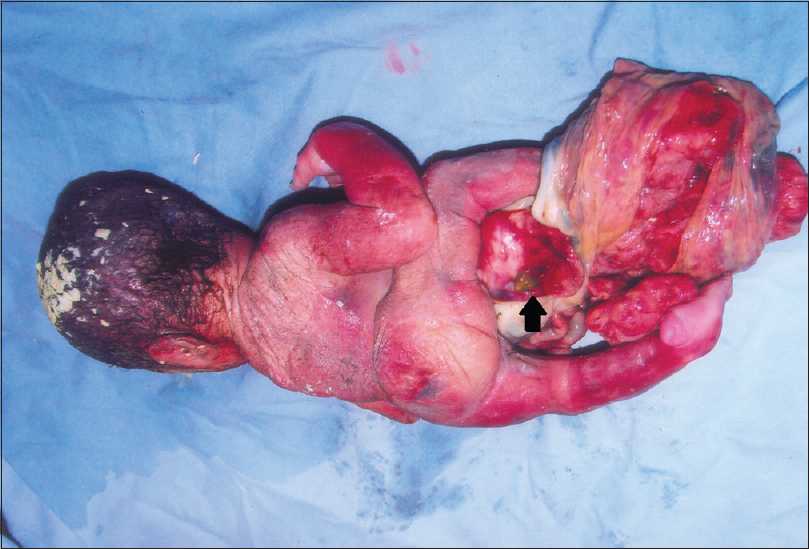 | Figure 1: Kyphoscoliosis, exstrophy of the cloaca with meconium coming out of ileal opening
Click here to view |
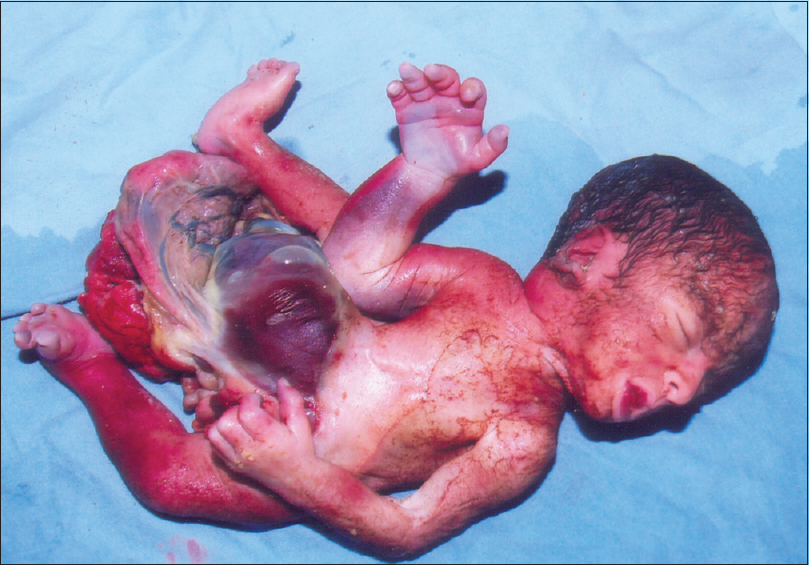 | Figure 2: The omphalocele with its contents-liver and loops of bowel. The placenta can be seen with the vessels directly attached to the lateral margin of the defect
Click here to view |
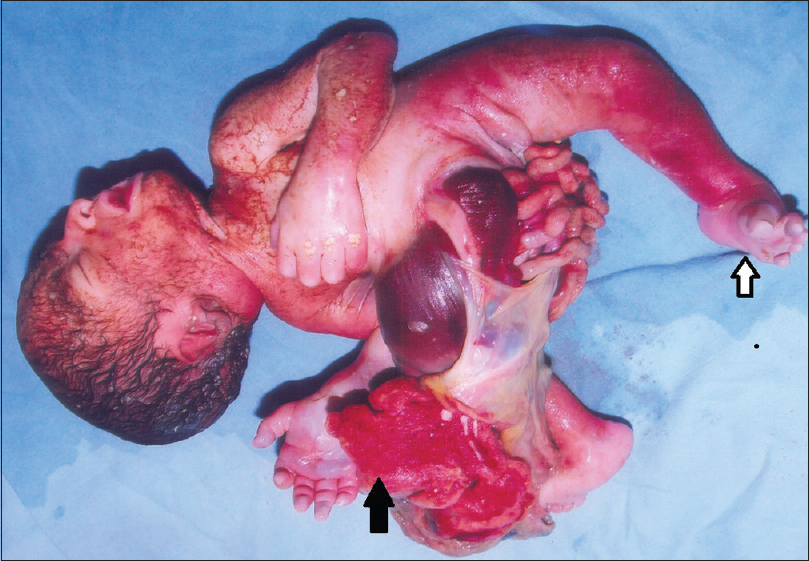 | Figure 3: The placenta (dark arrow) directly attached, with no cord and club foot (hollow arrow)
Click here to view |
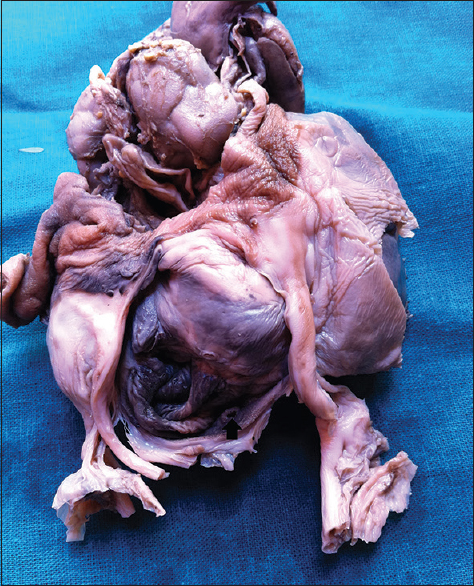 | Figure 4: Dissected en block specimen showing exstrophy of the cloaca with opening of the large bowel and small bowel opening (arrow). The vessels are seen laterally which are covered in a sheath (placenta is separated)
Click here to view |
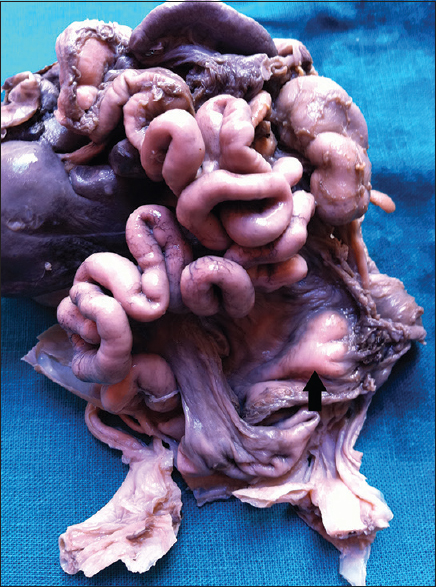 | Figure 5: Dissected specimen showing blind ending segment of the large bowel (arrow)
Click here to view |
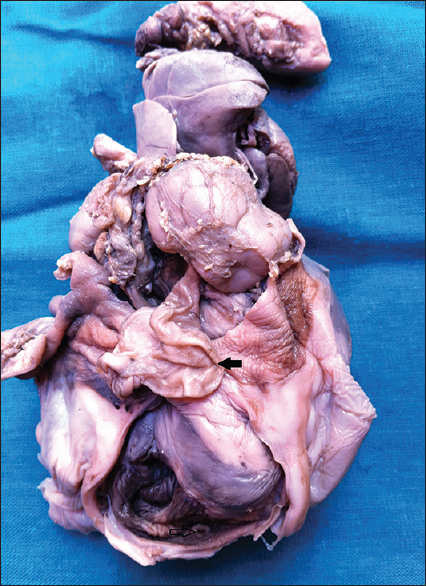 | Figure 6: Dissected specimen showing sac like dilatation of right ureter (arrow)
Click here to view |
 Discussion Discussion | |  |
The major syndrome complex associated with congenital anterior abdominal wall defect includes OEIS complex, LBWC and Pentalogy of Cantrell.
The term OEIS complex was first used by Carey et al. [8] Subsequently, it was statistically demonstrated that OEIS complex is a clinically recognized nonrandom association that, in addition to the four classic malformations (omphalocele, exstrophy of the cloaca, imperforate anus, and spine abnormalities) is variably associated with spina bifida, genital abnormalities, renal malformations, symphysis pubis diastasis, and limb abnormalities. [9] The clinical manifestations in OEIS have been reviewed from major case series recently. [2] Exstrophy of the cloaca includes the persistence and exstrophy of a common cloaca that receives ureters, ileum and a rudimentary hind gut.
Criteria used for prenatal diagnosis of exstrophy of cloaca that are described in the literature include: (a) Major criteria - Nonvisualization of the fetal bladder, infra-umbilical anterior abdominal wall defect, omphalocele, and myelomeningocele. (b) Minor criteria - lower extremity malformations (club feet), renal anomalies, ascites, widened pubic arches, narrow thorax, kyphoscoliosis, hydrocephalous, and single umbilical artery. However, despite these criteria often the full extent of anomalies cannot be identified prenatally. [6]
The prevalence of omphalocele and OEIS complex may be higher in fetuses with increased nuchal translucency. Possible mechanisms for increased nuchal translucency include: (1) Intrathoracic compression due to abdominal defects, leading to jugular lymphatic obstruction or (2) vascular or hemodynamic compromise early in embryologic development. [6]
The autopsy findings described in the present case included all the classical manifestations of OEIS, and also renal anomalies (hydroureter), widened pubic arch and club feet in agreement with those described in the literature. Apart from these one very interesting finding in our case was the body stalk anomaly. The umbilical cord was absent, and the umbilical vessels were embedded in an amniotic sheet, which connected the skin margin of the anterior body wall defect to the placenta.
Body stalk anomaly is an important finding of LBWC and considered to be synonymous with it. [3]
A critical analysis of the literature on LBWC revealed a varied and rather confused spectrum of cases, which were distinguished into two phenotypes-placento-cranial and placenta-abdominal type. [4] The present case had findings consistent with the placento-abdominal phenotype of LBWC. Anomalies of the placenta and the cord is an important feature of LBWC and some authors have stressed the importance of examining the placenta and the cord in such cases. [10]
Thus, this case is unique in the sense that it had findings, which were overlapping with OEIS complex and LBWC. Similar findings have been described by Shah et al. [11] In a review of cases of LBWC, exstophy of cloaca and urorectal septum malformation sequence, Heyroth-Griffs et al. found overlapping features between these conditions and have proposed that these conditions represent a spectrum of abnormalities, rather than three separate conditions and may share a common etiology and pathogenetic mechanism. [7]
 References References | |  |
| 1. | Ebert AK, Reutter H, Ludwig M, Rösch WH. The exstrophy-epispadias complex. Orphanet J Rare Dis 2009;4:23.  |
| 2. | El-Hattab AW, Skorupski JC, Hsieh MH, Breman AM, Patel A, Cheung SW, et al. OEIS complex associated with chromosome 1p36 deletion: A case report and review. Am J Med Genet 2010;152A: 504-11.  |
| 3. | Saritha S, Gouri, Sumangala. Limb body wall complex or body stalk complex or cyllosomas: A case report. Int J Res Med Sci 2013;1:132-7.  |
| 4. | Russo R, D'Armiento M, Angrisani P, Vecchione R. Limb body wall complex: A critical review and a nosological proposal. Am J Med Genet 1993;47:893-900.  |
| 5. | Cantrell JR, Haller JA, Ravitch MM. A syndrome of congenital defects involving the abdominal wall, sternum, diaphragm, pericardium, and heart. Surg Gynecol Obstet 1958;107:602-14.  [ PUBMED] |
| 6. | Keppler-Noreuil K, Gorton S, Foo F, Yankowitz J, Keegan C. Prenatal ascertainment of OEIS complex/cloacal exstrophy-15 new cases and literature review. Am J Med Genet A 2007;143A:2122-8.  |
| 7. | Heyroth-Griffis CA, Weaver DD, Faught P, Bellus GA, Torres-Martinez W. On the spectrum of limb-body wall complex, exstrophy of the cloaca, and urorectal septum malformation sequence. Am J Med Genet 2007;143A:1025-31.  |
| 8. | Carey JC, Greenbaum B, Hall BD. The OEIS complex (omphalocele, exstrophy, imperforate anus, spinal defects). Birth Defects Orig Artic Ser 1978;14:253-63.  [ PUBMED] |
| 9. | Källén K, Castilla E, Robert E, Mastroiacovo P, Källén B. OEIS complex - A population study. Am J Med Genet 2000;92:62-8.  |
| 10. | Colpaert C, Bogers J, Hertveldt K, Loquet P, Dumon J, Willems P. Limb-body wall complex: 4 new cases illustrating the importance of examining placenta and umbilical cord. Pathol Res Pract 2000;196:783-90.  |
| 11. | Shah HR, Patwa PC, Tannk AV, Pandya JB, Nayak C, Garacia R. A case report of foetus having combined features of LBWC+OEIS complex. Indian J Radiol Imaging 2005;15:85-8.   |
[Figure 1], [Figure 2], [Figure 3], [Figure 4], [Figure 5], [Figure 6]
|






